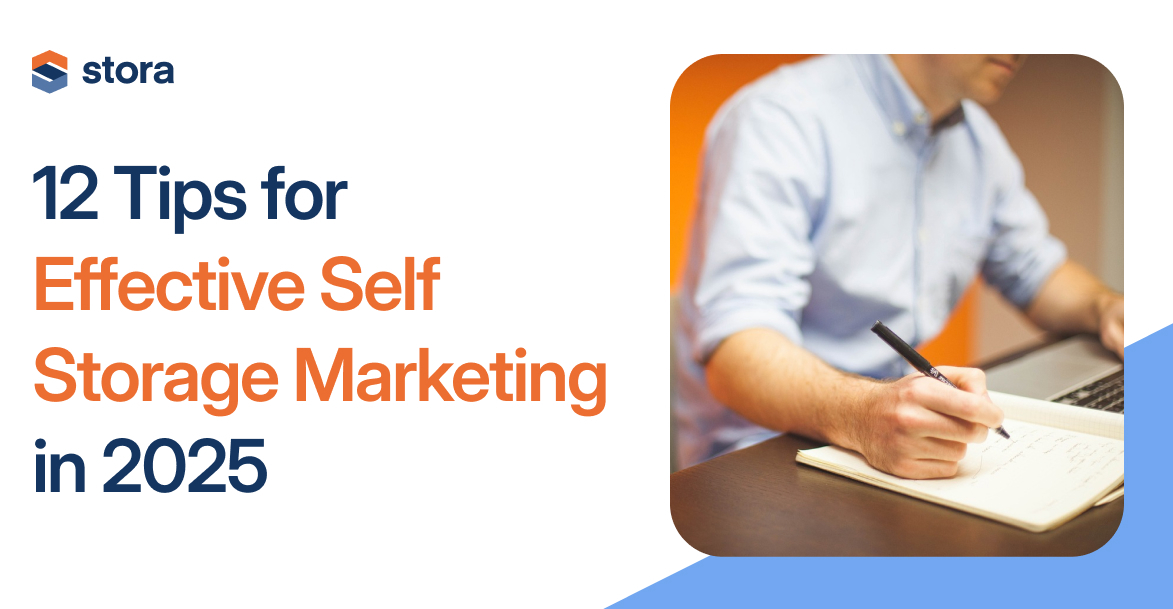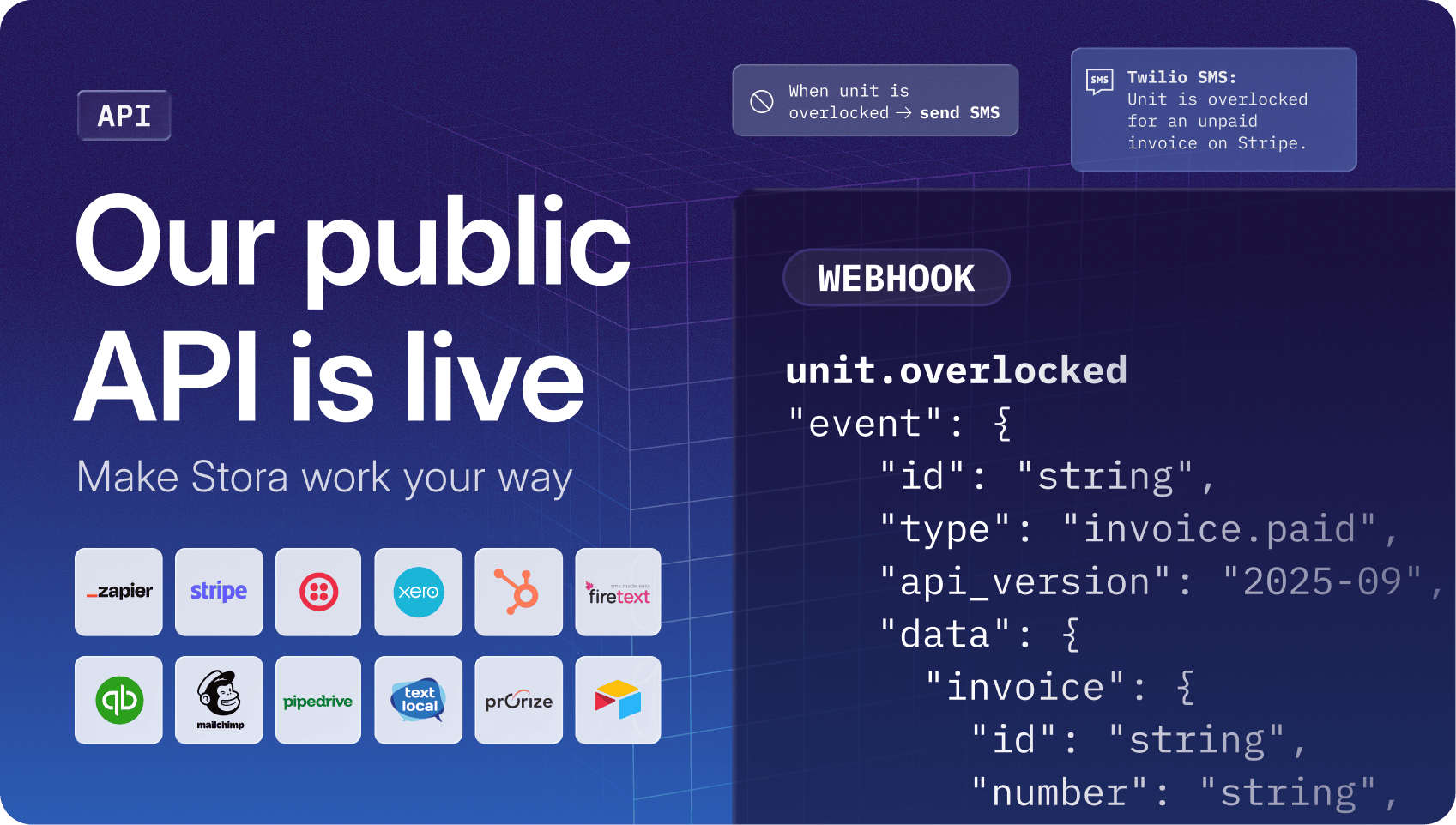Companies that focus on nurturing leads through marketing make 50% more sales. If you’re not spending time marketing your self storage facility, you’re missing out on a massive opportunity to improve your occupancy and profitability.
The right self storage marketing strategy can be critical for effectively competing against other businesses in your local area.
However, finding the right marketing strategy for your self storage business can be challenging, especially for operators who are new to the sector. In fact, only 61% of marketers believe their strategy is effective.
To help, we’ve created this guide on 12 key areas you need to consider before implementing your self storage marketing strategy. The guide focuses on understanding and meeting the needs of your self storage customers.
Tip 1: Understand Your Audience
Self storage is a local business. Customers are always looking for convenient options nearby.
According to recent data, 40% of customers contact the first store they choose, whereas 53% of customers travel less than 15 minutes to their self storage unit.
That's why it's essential for your marketing efforts to focus on customers within your local area.
Focus on understanding market trends and consumer behavior to identify the best ways to capture your target audience’s attention and align your marketing strategies with what customers want.
To better understand your audience and keep your marketing strategies on track, we recommend that you:
➡️ Segment your audience
Over 58% of marketers find targeting and segmenting their audiences challenging.
Divide your target demographic into distinct segments based on factors like:
Age
Location
Specific storage needs
Income
Then, create detailed customer personas—incorporating interests, pain points, and goals—to humanise your audience and keep your marketing strategies agile as customer needs evolve.
➡️ Conduct market research
Nearly 80% of companies conduct market research on their performance, customers, industry, and competition.
Gather insights into your audience’s behaviours, preferences, and pain points through surveys, interviews, and data analysis.
One of the best ways to conduct market research is to hire a professional research company like MRFGR, which can arrange things like focus groups and fieldwork.
Understanding customer needs and motivations will enable you to craft marketing campaigns that resonate and drive impactful results.
➡️ Analyse competitor strategies
Over 90% of businesses say their industry has become more competitive in the last three years.
For this reason, you need to study your competitors’ marketing tactics and audience engagement strategies to identify gaps and opportunities within your target market.
Benchmarking your services against your competitors in the self storage industry can refine your approach and differentiate your business.
➡️ Utilise customer feedback
More than 90% of consumers believe companies should listen to their feedback to fuel innovation.
Leverage feedback from existing customers to gain valuable insights into their experiences, preferences, and pain points.
Actively seeking out and incorporating customer feedback into your marketing strategies demonstrates your commitment to customer satisfaction and helps keep your messaging relevant.
Tip 2: Optimize Your Website
Did you know that 94% of first impressions are based on your website? Your self storage website serves as your business's virtual storefront and your best chance of establishing immediate trust with potential customers.
Our team suggests placing a focus on:
➡️ Consider the user experience (UX)
Your website needs to provide a seamless user experience (UX). Start with a visually appealing design that reflects your brand identity and builds trust with visitors.
To create a polished look, use clean layouts, professional images, and consistent branding elements like your logo and colors.
Some other UX elements to focus on include:
👉 Effortless navigation: More than 88% of website users won’t return to a site if they encounter poor navigation. A well-organized and intuitive navigation menu can make a big difference. Ensure that users can easily find the information they’re looking for, such as how to book, unit sizes, pricing, and location details. As a rule of thumb, customers should be able to access what they need within three clicks.
👉 Mobile optimization: Over 90% of users access the internet via mobile devices, so your site must be mobile-responsive. This means pages should load quickly, and all features should work flawlessly on any device. Test your website across different screen sizes to ensure a consistent experience.
👉 Self-service features: Empower your customers by offering the option to book units directly from your website. An easy-to-use reservation system can help convert leads into customers instantly.
👉 Clear call to action (CTA) buttons: Guide users through your site with strategically placed CTA buttons. Phrases like “Reserve Your Unit Today,” “Check Availability,” or “Contact Us Now” should stand out visually and prompt immediate action.
👉 Streamlined content: Avoid overwhelming visitors with dense text. Instead, use concise messaging paired with bullet points or visuals to communicate key details effectively.
➡️ Showcase your value proposition
Differentiating your self storage business by highlighting its unique selling points is critical for your marketing efforts.
This process sets you apart from competitors. You might choose to focus on amenities, security features, and the convenience of your location.
Always prioritize using engaging visuals, such as professional photography and virtual tours, to showcase your facility and create an impression on visitors.
Below is an example of a good value proposition from Self Storage Plus that focuses on features and the customer experience:
➡️ Ensure good website performance
Regularly monitor user behavior data and key performance metrics like website traffic, bounce rates, and conversion rates to identify areas for improvement across your website and enhance the user experience.
Page speed is an important aspect of your website's performance. Over 40% of consumers will abandon a website if it takes longer than three seconds to load. You can use the Google PageSpeed test to test your website's performance.
Get a High-Performance Website with Stora Stora is a self storage facility management tool that offers the design of storage websites. Our websites are optimized for excellent performance, a great user experience, and to generate tons of conversions. |
Tip 3: Leverage Search Engine Optimization (SEO)
Implementing search engine optimization (SEO) is essential for enhancing visibility and attracting potential customers online. Four out of five consumers conduct searches with local intent on search engines.
Prioritize SEO by conducting keyword research to identify terms and phrases related to self storage and the local area your target audience is searching for. A keyword is a term or phrase that people enter into search engines when they’re looking for something.
Add keywords to your website’s content, including your landing pages, blog articles, headings, and meta titles.
➡️ Focus on high-quality content
Search engine algorithms prioritize high-quality, relevant content that addresses the needs and questions of your target audience. By satisfying these criteria, you can organically improve your website’s ranking and visibility in search engine results pages (SERPs).
National Storage shares valuable, educational blog posts that address its target audience directly and answer their questions. They will rank for these keywords, which drives organic traffic and improves its overall ranking. It even provides a useful storage unit size guide to add extra value for their potential customers:
💡 Learn More About SEO To find out more, check out our full guide on SEO for self storage facilities. |
Tip 4: Focus on Local SEO and Your Google Business Profile
An important aspect of your SEO efforts is local search engine optimization. Over 98% of consumers use search engines to find local businesses, so local SEO, like having a Google Business profile (previously known as Google My Business), is essential to boost your online visibility.
Here are some key local marketing strategies to consider:
➡️ Claim and update your Google Business Profile listing
After claiming and verifying your Google Business Profile, ensure the listing is accurate and consistent with other online platforms.
This includes updating business information like name, address, phone number (NAP), business hours, and photos associated with the profile.
To entice potential customers, enrich your profile with high-quality photos showcasing your facility and its amenities.
Below is a good example of a Google Business Profile from Store-n-Lock Self Storage. The profile includes all their business information as well as high-quality images of their facility:
➡️ Encourage customer reviews and engagement
Over 99% of customers read reviews when searching for something online. This is why you should actively encourage satisfied customers to leave positive reviews on your Google Business Profile.
This will help encourage local word of mouth, support professional referrals, and enhance your business's credibility.
Below are some of Public Storage’s Google Business Profile reviews, giving them credibility and helping to build their brand:
➡️ Focus on local keywords and location-based content
Where possible, incorporate local keywords and phrases relevant into your website content.
If you’re targeting multiple locations, consider creating location-specific landing pages or blog posts to address customers' unique needs and interests in each area you serve.
Neighborhood Self Storage has a landing page dedicated to their self storage facilities in Colorado to help with their local SEO:
➡️ Optimize for Google Maps
More than a billion people use Google Maps every month. This is why verifying your location and providing detailed information about your facility is essential to ensure your business is accurately represented on Google Maps.
💡 Looking for Additional Insights on Local SEO and Google Business Profiles? Here are some popular resources we’ve created: |
Tip 5: Effective Paid Advertising
Paid advertising tactics like Google Ads have an average return on investment (ROI) of $2 for every $1 spent. This makes paid advertising a great option for marketing your self storage business.
Paid advertising involves paying for ad placements on platforms like Google, social media, or other websites to promote your storage facility.
This could include search engine ads that appear when potential customers search for storage solutions.
Pay-per-click (PPC) advertising on Google allows you to pay for your business to appear at the top of search results when users look for something online, as you can see below:
Paid ads also include display ads, which appear on various websites or social media, targeting specific demographics.
The goal is to increase visibility, attract more customers, and drive conversions—such as unit bookings or inquiries—by reaching people actively seeking self storage.
When developing your paid ads, you should do the following:
➡️ Craft engaging ads
Create attention-grabbing ad copy and visuals highlighting your self storage facility's unique selling points and benefits.
Use persuasive language and compelling imagery to entice users to click on your ads and learn more about your offerings.
Here are some examples of engaging self storage Facebook ads from ClickStorage:
➡️ Set realistic budgets and targeting options
Determine your marketing budget based on your business goals and allocate funds strategically across different campaigns and ad platforms.
Use targeting options to reach your ideal audience effectively, including their:
🎯 Geographic location.
🎯 Demographic characteristics, like age, income, and household size.
🎯 Interests, such as moving, home organization, or decluttering.
🎯 Online behaviors, including searching for storage solutions or engaging with related content.
➡️ Experiment with ad formats
Experiment with different ad formats, placements, and messaging to identify which combinations resonate best with your target audience.
Test variations of ad headlines, descriptions, and calls to action to optimize campaign performance and maximize ROI.
➡️ Use ads to build brand awareness
By focusing your advertising efforts on location-specific keywords and featuring your brand name front and center, you can build brand awareness and increase the likelihood of conversions from those already familiar with it.
➡️ Monitor and optimize ad performance
Monitor key performance metrics like click-through rate (CTR), conversion rate, and cost-per-acquisition (CPA) regularly to gauge the effectiveness of your paid advertising campaigns. Use this data to identify underperforming ads and make adjustments accordingly.
Tip 6: Content Marketing
Quality content is king. The right approach to content can attract and retain customers while building credibility and authority for your business. Over 80% of marketers say that content marketing has helped them to build brand awareness and grow loyalty.
To create the right content marketing strategy, you should:
➡️ Develop a content calendar and plan
Create a content calendar outlining the topics, formats, and publishing schedule for your content. This ensures a consistent flow of relevant content that engages your audience throughout their decision-making process.
➡️ Provide valuable and informative content
Focus on creating high-quality, informative content that educates and empowers your audience.
Offer tips, insights, and practical advice related to self storage solutions, moving tips, organization hacks, and decluttering strategies to position your brand as a trusted voice in the industry.
ExtraSpace Storage offers informative, high-quality content on their blog to educate their audience and improve their search engine rankings:
➡️ Diversify your content formats and channels
To appeal to different audience preferences and habits, experiment with various content formats, such as blog posts, videos, and infographics.
➡️ Partner with influencers
Engage with local influencers or micro-influencers who resonate with your target demographic to share authentic endorsements and recommendations for your self storage services.
Storage Sense and Valley Storage recently partnered with two niche social media influencers to promote their facilities. This initiative led to more than a dozen new rentals for each new facility.
➡️ Measure and analyze content performance
Track key performance metrics, such as website traffic, engagement metrics, and lead generation, to evaluate the effectiveness of your content marketing efforts.
Use analytics tools to identify top-performing content, understand audience behavior, and make data-driven decisions to optimize your content strategy for better results.
Tip 7: Leverage Social Media
Over 75% of consumers want brands to use social media to connect with them. Additionally, 71% of users are more likely to make a purchase if they’re referred by social media.
The benefits of social media are clear. What’s less clear is how new or growing businesses can maximize their presence on these platforms.
So, aside from leveraging paid advertising and integrating content creation strategies, how can you get more from social media for your self storage business?
To identify the right social media strategy for your self storage business, we suggest:
➡️ Choose the right platforms
Identify the social media platforms where your target audience is most present and active.
For example, 22% of 40 to 49-year-olds use Facebook, and 32% of 30 to 39-year-olds use Instagram.
To start, we suggest focusing your efforts on platforms like Facebook, Instagram, X (formerly Twitter), and LinkedIn.
➡️ Engage with your audience
Promote more meaningful interactions with your audience by promptly responding to comments and messages and hosting contests and Q&A sessions to build a sense of community among your followers.
Additionally, encourage user-generated content (UGC) by sharing genuine customer testimonials and reviews.
➡️ Monitor competitor activity
Keep an eye on your competitors' social media activity. Pay attention to the types of content they share, the engagement they receive, and the promotions they run.
This information can help you refine your own social media strategy and develop more effective promotions.
➡️ Consistently carry out social listening exercises
Social listening exercises can be a great way to track mentions of your brand across various online platforms, including social media channels, review websites, and forums.
This will not only help you find out where your customers are, but it also acts as a direct line to your customers’ needs.
➡️ Tell people how to book units
Use your social media platforms to inform potential customers how to reserve or book a storage unit at your facility. You could do this by sharing a link to your bookings section on your website.
➡️ Share photos of your facility
Social media is all about visuals, so ensure you share high-quality images of your storage facility on your platforms to attract potential customers.
The social media posts below from Cubesmart as part of their Made to Keep campaign include a high-quality image of their facility and a short and engaging description:
➡️ Post about community involvement
If your business is participating in community events or has formed partnerships with local businesses, be sure to post about this on your social media platforms for additional exposure.
Vanguard Self Storage regularly publishes posts on Facebook about its community involvement to promote their brand:
Tip 8: Encourage Customer Reviews and Testimonials
More than 75% of consumers trust online reviews. Positive or negative, customer reviews can have a huge impact—especially in an industry like storage, where trust, security, and convenience are essential.
How you approach customer relationship management will directly impact your online reviews.
To encourage positive reviews and manage your online reputation more effectively, we recommend:
➡️ Create a feedback loop
A feedback loop is a systematic approach to gathering and responding to customer feedback.
By establishing a structured process, you can make it easier for customers to share their thoughts, whether it’s about their overall experience, the condition of their storage unit, or any other aspect of your self storage facility.
➡️ Establish multiple feedback channels
Offer customers various ways to provide feedback. These can include everything from online surveys and social media conversations to direct feedback via email or phone.
By providing multiple avenues for feedback, you increase the likelihood of receiving more insights from a broader range of customers.
➡️ Incentivise reviews
Offer incentives like discounts, freebies, or loyalty rewards to customers who leave positive reviews or refer new customers to your business.
Just be sure to comply with platform guidelines and regulations regarding incentivized reviews.
➡️ Showcase testimonials in marketing materials
In your marketing materials, website, and social media channels, feature positive reviews, testimonials, and success stories from satisfied customers.
Use authentic, relatable testimonials to build trust and credibility with potential customers and showcase the value of your self storage services.
SelfStorage Plus displays their Google Profile reviews on their website to build credibility and trust with potential customers:
➡️ Contact those who leave you negative reviews
Ignoring negative reviews won’t get rid of them. Instead, you should respond to negative reviews and address customer complaints. You can use this as an opportunity to learn from your customers and improve your business.
➡️ Run a contest
This is an effective way to market your business with help from your current customers. Run a simple contest on your social media platforms asking for customer reviews in exchange for a prize.
You can also ask your customers to share photos as entries into your contest, which will give you additional content to share on your marketing channels.
➡️ Include a name and picture
Doing this is a great way to give credibility to customer reviews and thank them for posting them.
Consider adding the source of the review, such as Yelp, to encourage other customers to give you their feedback.
💡 Ask Customers to Share Their Experience If you’re confident that your self storage facility offers an exceptional customer experience, it’s always worth asking customers to share their experiences with you and on public channels. Consider sending follow-up emails after a customer moves out as part of your feedback loop. You can also provide links to review platforms, short surveys, or instant rating windows for convenience. With a more personalized approach, you can maintain good customer relationships and gather valuable insights to improve your self storage services. |
➡️ Implement changes based on feedback
Use the insights gained from customer feedback to implement company-wide changes to your facilities, services, or policies as needed.
Continuously monitor the impact of these changes and seek further feedback to ensure their effectiveness and customer satisfaction.
Tip 9: Email Marketing
The average ROI for email marketing is between $36 and $40 for every dollar spent, making it a worthwhile investment for your business.
Email marketing remains a highly effective tool for nurturing customer relationships, driving conversions, and encouraging repeat business.
To create an effective email marketing strategy, we suggest:
➡️ Create an email list
The first step is building a targeted email list. Start by collecting email addresses from customers who have inquired about your services, signed up for newsletters, or used your facility in the past.
Another way to find email addresses is to use tools like hunter.io, which gives you access to contact details in seconds.
You can also gather addresses through your website, social media channels, and promotions.
➡️ Write a good subject line
Your subject line is the first thing your subscribers see, so it needs to be compelling. A good subject line grabs attention, creates curiosity, and entices the reader to open the email. Keep it short, clear, and relevant.
Examples of good subject lines include:
💬 Need More Space? We’ve Got You Covered
💬 Unlock Your Storage Solution Today—Special Offer Inside
💬 Time to Clear Out? Get [X% off] Your First Month
💬 Moving? Here’s a Storage Deal You Can’t Miss
💬 Safe, Secure, and Affordable Storage—Reserve Yours Now
➡️ Create a compelling email
Once you’ve got their attention, keep the email content engaging. Be concise, informative, and friendly while focusing on the value your facility offers. We recommend keeping the message to around 150 words and definitely no more than 250 words.
You can highlight promotions, seasonal offers, or tips for using self storage efficiently.
➡️ Avoid spam filters
To ensure your emails reach inboxes and not spam folders, avoid using excessive capital letters, multiple exclamation marks, or words commonly associated with spam, such as “free” or “urgent.”
➡️ Use automation
Consider using software like Mailchimp, Constant Contact, or HubSpot to streamline your email marketing.
These tools allow you to automate your campaigns, segment your email list, and personalize messages based on customer behavior or demographics.
Automation can save you time and ensure you send the right message to the right people.
➡️ Focus on personalization
Tailor your email content to specific audience segments based on their preferences, behavior, and past interactions with your business.
Use these personalized recommendations to deliver relevant, engaging messages that resonate with each recipient.
➡️ Send personalized communications
Personalized emails achieve an excellent open rate of 29% and a CTR of 41%.
Use your customer relationship management (CRM) data to send personalized communications to current and past customers.
Segment specific parts of your audience based on their preferences, behavior, and past interactions with your business.
Consider sending reminders, customer anniversary messages, or special offers tailored to their storage needs. Personalized emails can make customers feel valued and appreciated.
➡️ Automate your workflows
Implement automated email workflows to streamline your communication processes and deliver timely, targeted messages to subscribers at different stages of the customer journey.
For example, consider setting up automated welcome emails, abandoned cart reminders, follow-up sequences, and re-engagement campaigns to nurture leads and drive conversions.
➡️ Optimize for mobile
More than 41% of emails are viewed on mobile devices, so ensure your email campaigns are optimized for mobile responsiveness.
Make sure your emails read well across all screen sizes and devices and provide a seamless user experience for mobile users.
➡️ Monitor results
After sending out your emails, it’s important to track their performance. Use the analytics your email marketing software provides to monitor open rates, click-through rates, and conversion rates.
This data will help you refine your strategy and optimize future campaigns, ensuring you get the most out of your email marketing efforts.
➡️ A self storage email marketing template
Below is a self storage email marketing template that incorporates all the advice above for you to use:
Subject Line: Need Extra Space? We Have A Special Offer Just for You.
Hi [First Name],
We know life can get cluttered sometimes, and finding extra space for your belongings can be a real challenge. At [Facility Name], we're here to help make that easier! Whether moving, decluttering, or just needing extra room, we have the perfect storage solution.
Here’s why you should choose [Facility Name]:
Affordable rates: We offer flexible pricing plans to suit your budget.
Convenient location: Our facility is easily accessible, making storing and retrieving your items a breeze.
24/7 security: Rest assured, knowing your belongings are safe with us.
Special offer: For a limited time, get [X% off] your first month when you reserve a unit online!
What’s next?
It’s easy to secure your storage unit with us. Simply click the button below to book online and take advantage of our special offer:
[Book Your Storage Now]
Don’t wait! This offer won’t last long, and we'd love to help you clear up some space.
Thanks for choosing [Facility Name] — we look forward to serving you!
Best regards,
The [Facility Name] Team
Tip 10: Partnerships and Networking
Partnering with local businesses, communities, and organizations opens up new opportunities for your self storage business. Networking in the ever-changing storage industry keeps you informed on trends, growth, and competition.
To boost your authority and strengthen your local presence, consider:
➡️ Be strategic about potential partners
Identify local businesses and organizations that align with your self storage mission and target audience. Look for collaboration opportunities with moving companies, real estate agencies, home staging pros, and community groups to ensure meaningful partnerships.
Lock+Store partnered with a moving company called Packers Xpress to streamline the moving process for their customers. They sent out a press release regarding their collaboration and received some impressive press coverage as a result:
➡️ Attend networking events
Attend local networking events, industry conferences, and expos to connect with professionals in your area. Networking helps build relationships, spark ideas, and uncover long-term partnership opportunities for your self storage business.
➡️ Get involved in the community
To demonstrate your commitment to the local community, sponsor events, support charitable causes, or participate in community initiatives.
Sponsoring sports teams has become a popular strategy for many self storage operators.
Building a positive reputation and establishing goodwill within the community can help attract new customers, connect with potential employees, and strengthen your brand presence.
➡️ Establish a referral program
Implement a referral program that incentivizes existing customers and partners to refer new clients to your self storage facility.
To encourage word-of-mouth marketing, offer rewards such as discounts on storage space rentals, gift cards, or free storage upgrades for successful referrals.
💡 Looking for Low-Cost Self Storage Marketing Ideas? Read our guide on Low-Cost Marketing Ideas for self storage businesses for more helpful insights. |
Tip 11: Experiment with Offline Marketing
Offline marketing can still be a valuable tool for reaching local audiences. Here's how to harness the power of print advertising to promote your self storage business:
➡️ Advertise in local publications
Consider advertising in local newspapers, magazines, and community newsletters to target residents in your area.
These publications often have loyal readerships and can provide a cost-effective way to reach potential customers needing storage solutions.
➡️ Consider direct mail campaigns
Did you know that direct mail response rates are five to nine times higher than any other advertising channel?
Try direct mail campaigns, such as sending flyers, leaflets, or mailers to target specific neighborhoods or demographics with promotional offers and information about your self storage facility.
Use eye-catching designs that highlight your key selling points and provide a compelling call to action to encourage recipients to inquire about your services.
➡️ Use billboards and outdoor signage
Invest in billboards or outdoor signage strategically placed near high-traffic areas like busy roads or shopping centers. Billboards drive an ROI of 38%.
Use bold graphics, concise messaging, and your facility's location to attract attention and drive awareness.
Tip 12: Analyze and Improve
Effective marketing requires continuous monitoring and optimization based on data-driven insights.
As your business grows (and algorithms change!), you need to be able to adapt your strategies accordingly.
Here are some key steps to consider:
➡️ Set clear goals and key performance indicators (KPIs)
Define specific, measurable goals for your marketing campaigns, like increasing website traffic, generating leads, or boosting conversion rates.
Then, identify the KPIs that align with these goals and use them to track progress and measure success.
➡️ Monitor customer feedback
As good as analytics tools are, it’s still important to remember that customer feedback never lies.
So, pay close attention to customer feedback, reviews, and comments across various channels to identify areas for improvement and address any issues or concerns customers raise.
➡️ Regularly review and adjust strategies
Continuously monitor and evaluate your marketing performance against your goals and KPIs. Identify trends, patterns, and opportunities for optimization and make data-driven decisions based on this information.
See Ultimate Marketing Success with Stora
Creating a successful marketing strategy can be challenging, especially when juggling everyday business operations and growth strategy plans.
But with careful planning, execution, and the right investment of your time and resources, you can position yourself for success.
Are you spending too much time on administrative tasks to work on marketing your self storage business? Stora can help!
Our all-in-one self storage software solution can automate almost every aspect of your self storage facility, including tedious admin, so you have more time to spend on high-impact activities like marketing.
Additionally, our software provides you with a host of tools to help you tailor your marketing strategies, including:
✅ A fully integrated booking system.
✅ Customer insights and analytics.
✅ Automated emails.
✅ SEO-friendly web design.
Book a free Stora demo and learn how we can help you automate your busy work so you can focus on growing your business with effective marketing.








